 |
| Ominous skies over a deceptively calm lake. |
Risk assessment is an everyday practice. It’s not reserved for dire situations and dramatic scenarios; it’s the quotidian act of taking relevant safety factors into consideration and adjusting your plan accordingly.
Saturday provided a great example of risk assessment in action. We had arranged a downwind paddle with our local friend Greg Anderson, and out-of-town visitors Patrick Rota and Rebecca Merz. Rebecca drove three hours to join us, and all of us planned our day around a 12- to 14-mile run with a strong wind at our backs. The weather warranted caution — 15- to 25-knot winds and a slight chance of rain and thunderstorms in the morning, and clear in the afternoon — but there was nothing concerning on the radar, and by the time we were ready to get on the water, only the winds had materialized.
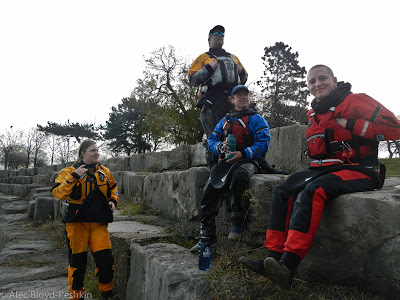 |
| Sizing up the skies before getting back on the water. |
As soon as we left the harbor, however, we were able to get a better look at the sky. A massive dark cloud with shaggy edges loomed to the northwest, and it was moving swiftly toward the same direction we were headed if we continued on our route. We passed the next headland and landed on a small beach below some limestone blocks, where we reassessed our situation. Thunder rumbled and cloud-to-cloud lightning flashed in the distance. We had access to the radar on our smartphones, which showed not only this unexpected storm cell, but a mass of others that had emerged and were moving toward us. And behind them, an angry-looking front had formed. After some discussion, we agreed that continuing would be foolish; it was time to head back.
 |
| Watching the thundercloud recede before getting back on the water. |
We waited for the first thundercloud to move over the lake north of us, and then headed south to retrace our route. But as we came around the headland, we saw a second thundercloud approaching, with more thunder and lightning, including a few cloud-to-ground strikes. We sprinted for the nearest beach and huddled, once again, near some limestone blocks as the rain pelted down.
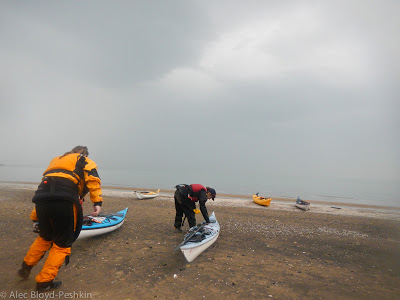 |
| Getting ready to launch again after the second stop. |
As the sky brightened in the west, we set out again, confident we could round the next pier and get back to our launch site–a distance of less than a mile. We even had time to practice a few rescues en route.
 |
| Rebecca empties Alec’s boat during a practice rescue. |
But as quickly as the sky had brightened, it darkened again. The rain resumed, along with more thunder and lightning.
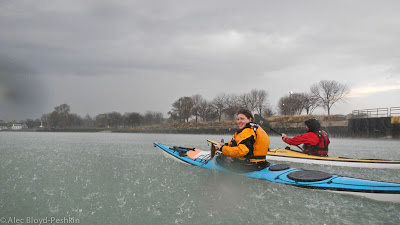 |
| Heavy rain drops made divits as they landed. |
Less than half a mile from our destination, we took refuge next to a shuttered park district building as the storm raged past us and out over the lake.
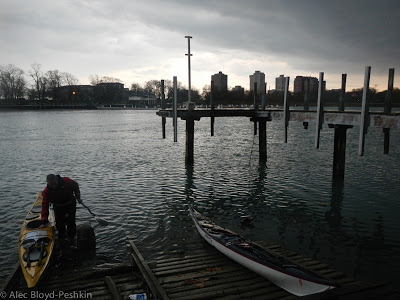 |
| Getting off the water again. |
We watched the storm recede to the east, then launched once more. The air pressure changes had induced a moderate seiche, which formed an eddy behind a nearby pier. Wary of another storm cell, we paddled back to our put-in.
 |
| Third stop during our trip back to our launch site |
In the end, we paddled about four miles in just about the same number of hours–most of it sprinting. It certainly wasn’t the day we had planned.
As we drove home, we discussed the decisions we had made.
First, we chose to get on the water in spite of the forecast indicating a slight chance of thunderstorms. Had we been unduly influenced by our desire not to disappoint visiting paddlers? But based on our experience with similar weather patterns, and the frontal maps we checked before leaving, there was no indication that there would be a thunderstorm in our area. To mitigate the risk further, we chose a route with lots of outs and alternative options.
Second, should we have turned around as soon as we saw the clouds ahead and to the west? Yes, that would have been a better choice. Fortunately, our route provided plenty of outs, and we were able to turn around a short distance later.
Finally, did we rely too heavily on our smartphone access? What if we hadn’t been able to get updated radar information? This easy access certainly did allow us to verify what we saw in the sky, and it did enable us to expect more storm cells behind the ones that were visible, but we had chosen a conservative route and certainly would not have been more reckless without it. In fact, we had ruled out paddling to the offshore water intake cribs on the basis of what we saw above us, not what we saw on the screen.
It’s good to debrief after even the most banal paddle outing because there are always things to learn. Nothing bad happened that day. We mostly made good decisions. In retrospect we realize that we should have turned back earlier than we did. Yet in the end, it wasn’t even a half-bad day on the water.
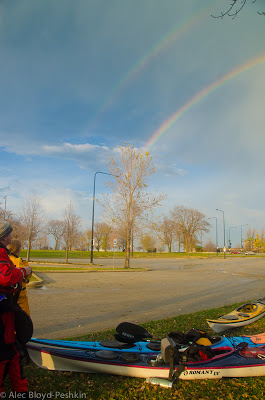 |
| A double rainbow appeared after we got off the water. |







